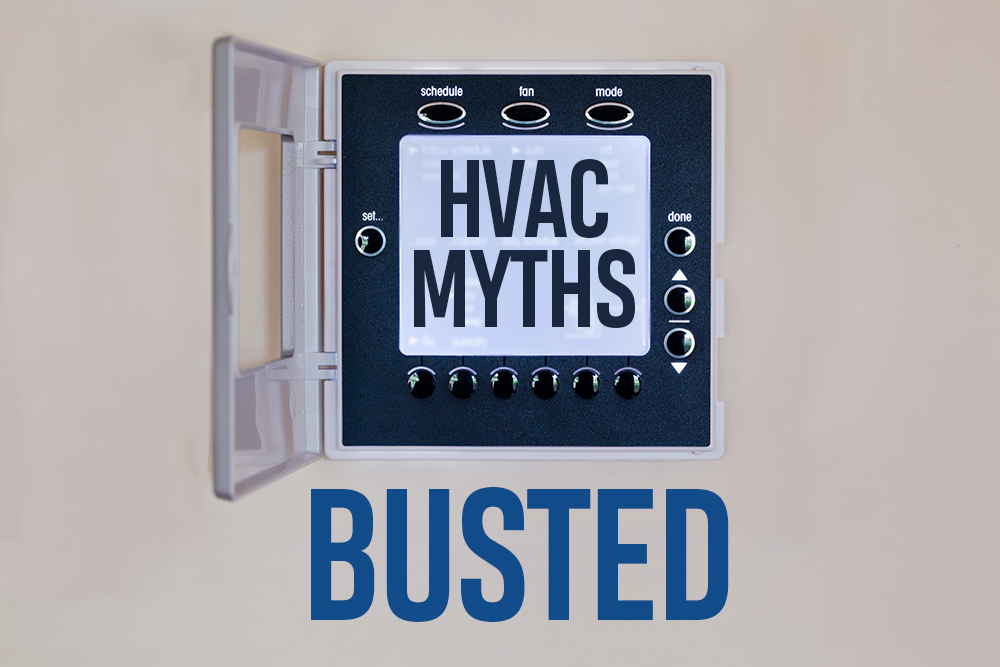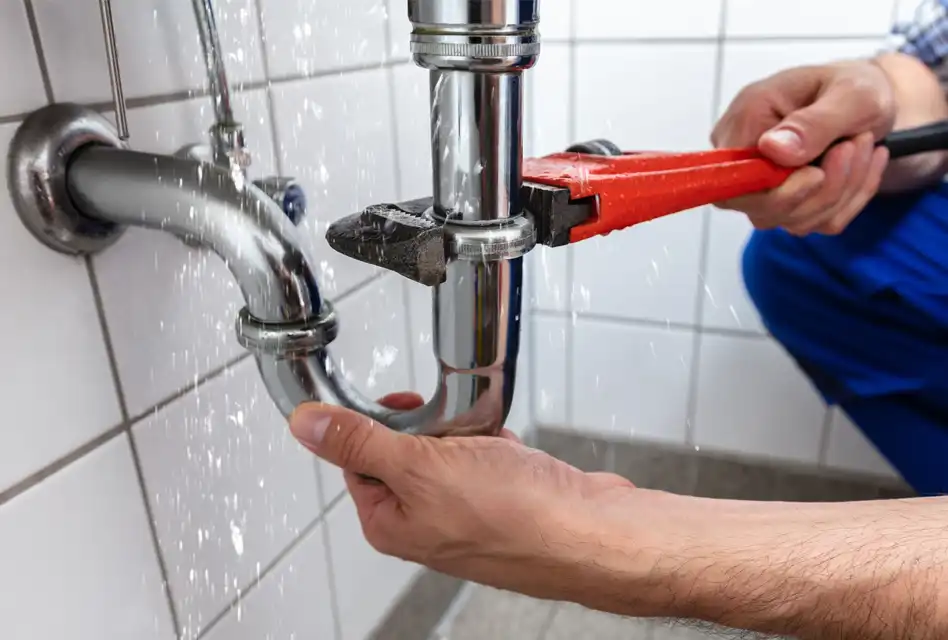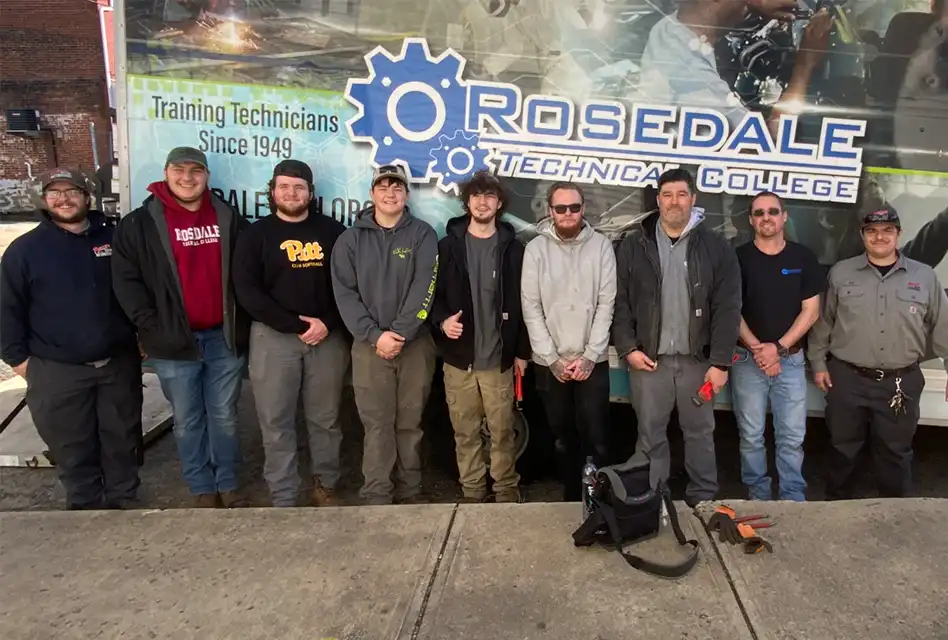Let’s Bust Some HVAC Myths!
Between changing the filter, scheduling routine maintenance and heating or cooling your home in the most efficient manner, there’s a ton of information out there on how to best maintain your HVAC system. Let’s face it. Heating and cooling might not seem like rocket science. However, it’s complex and can leave many consumers researching which option is best suited for their home.
Oh yes, there’s the internet, where you can find information on literally everything there is to know. But that doesn’t mean the information you’ll discover is inevitably true. And it can create some pretty big problems when you’re faced with, and believe, false information. For instance, you can type in a question about an important appliance in your home and receive a bunch of helpful “tips.” This is one of the reasons that misconceptions about HVAC systems have spread widely among homeowners.
Don’t sweat it. We’re busting some of most common heating and cooling myths to help keep you and your family comfortable and maintain that HVAC system in good working order.
Just like the tooth-fairy and the alligators in the sewers, the following myths can be the source of some serious confusion. Understanding them is the first step in getting the most out of your heating and air conditioning.
Myth #1: Routine maintenance isn’t necessary—“If it ain’t broke, don’t fix it.”
Busted. Because HVAC systems are so durable, many people believe they don’t require regular maintenance.
Yet, you wouldn’t even think to drive your vehicle for miles and miles without changing the oil, rotating the tires or replacing the brake pads. So why would anything be different when it comes to your heating and air conditioning calling for the same consideration and service? It’s quite simple: HVAC units have to be maintained on a routine basis.
Your HVAC system operates with a complicated network of parts and, over time, the pieces will need lubricated or replaced to keep the system running smoothly.
Fact is, one of the jobs of routine maintenance is to discover problems developing in the system, so they can be managed before they become worse. Repairs are not always obvious, but regular maintenance helps to make certain that little problems don’t turn into big ones. While it might seem there’s nothing wrong with your system at present, it’s very possible there is a small, undetected issue that could turn into a big problem later.
While it’s good to know how to manage your HVAC system yourself, it’s also helpful to know when to call the pros. In fact, a preventative maintenance program with a respectable HVAC contractor will arrange for scheduled inspections to ensure peak performance and might possibly lead to your HVAC system lasting past its expected life span.
Myth #2: Service agreements are a waste of money.
Busted. The inconvenience, irritation and issues associated with HVAC system breakdowns can be pricy in parts, labor and even system repair or replacement and can all be prevented with routine maintenance. A good preventative maintenance agreement with a well-respected and properly vetted HVAC service provider is a small price to pay for peace of mind.
In fact, most service agreements are budget-friendly and designed to catch small problems before they worsen.
To learn more about preventative maintenance contracts, give the service pros at Phillips Heating & Air Conditioning a call.
Myth #3: Air filters don’t need changed on a regular basis.
Busted. Over time, dirt, dust and moisture block air filters. Though a variety of air quality factors affect how quickly this will occur, in general, the dirtier they get, the less efficiently your equipment will run.
Many homeowners mistakenly believe that the air filter is only there to protect their indoor air quality. Truth is, a clogged HVAC filter makes it much harder for the ventilation system to circulate air properly. This results in the fan or blower motor working harder than it was intended to do and may even cause the A/C to freeze up.
It may also contribute to wearing out the equipment much earlier than it should, leading to repair or replacement costs. Also, it’s to be expected that more dust and other particles find their way through a clogged filter and onto the fan or blower motors and into contractors, where it can cause damage, inefficient operation and even premature failure.
If you have your heating and cooling unit tuned up once or twice a year, that’s great. However, most HVAC units need to have filter changes done every 30 to 90 days. Don’t wait until your bi-annual appointment to take care of this chore.
No matter how you slice it, a clean filter changed often is far less costly than a unit repair.
Myth #4: A thermostat’s location doesn’t affect the HVAC system.
Busted. If the thermostat is in an area of the house that is shadier or sunnier than most of the other rooms, you’re going to experience poor heating or cooling. Avoid proximity to air vents, windows and direct sunlight. Also, stay clear of areas with an abundance of appliances, such as the kitchen, that frequently warm up. Ideally, the thermostat should be on an interior wall in a room where you and your family spend the most time.
Myth #5: The bigger the air conditioner, the better it will be able to cool the house.
Busted. A larger HVAC system doesn’t automatically mean bigger savings or more comfort. When replacing your heating or cooling system, it’s critical to make certain it’s properly sized. The best HVAC system for any home is one that is specifically suited for the insulation level, square footage and number of windows.
An oversized unit may heat and cool the home to your satisfaction, but will likely have recurrent on and off cycling, which can result in high humidity conditions inside the home. Other comfort problems, such as dust leaking from ductwork and poor air distribution are also apt to occur.
On the other hand, an undersized unit may run longer than necessary, driving up your energy bill.
If your HVAC technician is doing his or her job correctly, they will measure your home and completely evaluate your current system. Anyone who just swaps your current system with a comparably sized one is taking a risky shortcut which could lead to higher energy bills, voided warranties and any number of other such problems.
Learn about Installation & Replacement.
Myth #6: Ceiling fans help cool spaces even when you’re not at home.
Busted. Ceiling fans don’t actually cool a room. Fans make you feel cooler, but only because of the wind-chill effect, similar to what your meteorologist warns about during a harsh winter. If you’re present in the room, turning on a fan will make you feel cooler so you can stay comfortable even when your home is set to a higher temperature. Ceiling fans allow you to set the thermostat higher while still feeling a comparable comfort level.
The lesson? Only use ceiling fans to augment the cooling when you’re in the room. Turn fans off when you leave. Fans are only effective when there’s someone in the room to enjoy them. Oh, and turn your HVAC system back if you want to experience any kind of energy savings. While HVAC systems cost dollars per day, ceiling fans cost cents.
Myth #7: Maxing out the A/C speeds up the cooling process.
Busted. Many people believe that their A/C unit will cool their rooms faster if they start with the lowest possible temperature setting and then adjust the temperature back to the desired setting. Although it seems like common sense to crank the A/C all the way down when it’s hot, truth is, HVAC systems are specifically designed to cool the air in a constant state.
Your HVAC system cools your home at the same speed regardless of how low it’s set. In fact, switching from an extreme setting and then back to your desired setting only puts unwanted stress on the unit, not to mention consuming too much energy. It may also cause the system to literally “freeze up” if set too low.
Air conditioning repair experts propose keeping your A/C unit at the desired temperature from the start.
The same can be said for the heating season. Take a gentler approach and adjust the temperature up a degree or two. In the meantime, dress appropriately for the season, which means wearing more clothing in the winter and less in the summer.
Myth #8: Closing off vents and registers will help reduce my heating and cooling costs.
Busted. A common HVAC myth is that by closing off the vents in an unused room, you’ll save money. Like many such myths, this one appears true at first. Unfortunately, despite the fact that vents and registers have levers that allow you to close off the airflow, the reality is that closing them can actually boost your energy costs.
An HVAC system is precisely designed to sustain a balanced air pressure so that it can effectively move air around your home. When you block one or more vents, either intentionally or not, you throw the air pressure off balance and cause the system to work harder, meaning it uses more energy to regulate your home’s temperature. In addition, to potential airflow problems, you may develop duct leaks as well.
This is especially true if you have an older system currently in place.
So, if you want to save money, consider adjusting the temperature rather than closing off the vents.
Be sure you also go around your home and make sure that no furniture, rugs, drapes, clothing or anything else is blocking your vents and registers.
Myth #9: Duct tape is a good product for sealing air duct leaks.
Busted. Ironically, despite the name, duct tape is not a good product to seal air ducts. It tends to peel and not stick very well.
If you’re sealing the air ducts, it’s recommended going with a service technician to do the job. However, it you’re into sealing the air ducts yourself, it’s suggested using aluminum foil tape or, preferably, mastic sealant, which actually is the best way.
Myth #10: The best way to solve a hot and clammy room is to stick a portable air conditioner in the window.
Busted. While installing a window air conditioner may seem to be the easiest way to cool down a room, in reality, you may have a more severe airflow problem with your central HVAC system. Ignoring it by sticking an A/C in the window may even worsen the situation. The best way to resolve any hot and cold spots is to schedule a professional HVAC maintenance session and addressing the source of the problem without wasting even more energy with a new window A/C.
Another great way to improve the overall comfort of your home is by investing in weatherization improvements, such as attic insulation, duct sealing and caulking around windows and doors.
Be ready when there is a problem.
Like most things in life, HVAC systems have a lot of myths surrounding their usage and functionality. But, fortunately, most of these myths are easily busted in time to prevent serious problems. However, sometimes people don’t’ get corrected on these myths fast enough and their HVAC system malfunctions and requires service.
Fortunately, when your HVAC system runs into issues, Phillips Heating & Air Conditioning is here to help to get the problem fixed fast and affordably.
When you’re looking for the right people to work on your HVAC system, trust the certified technicians at Phillips to keep you and your family comfortable year ‘round.







